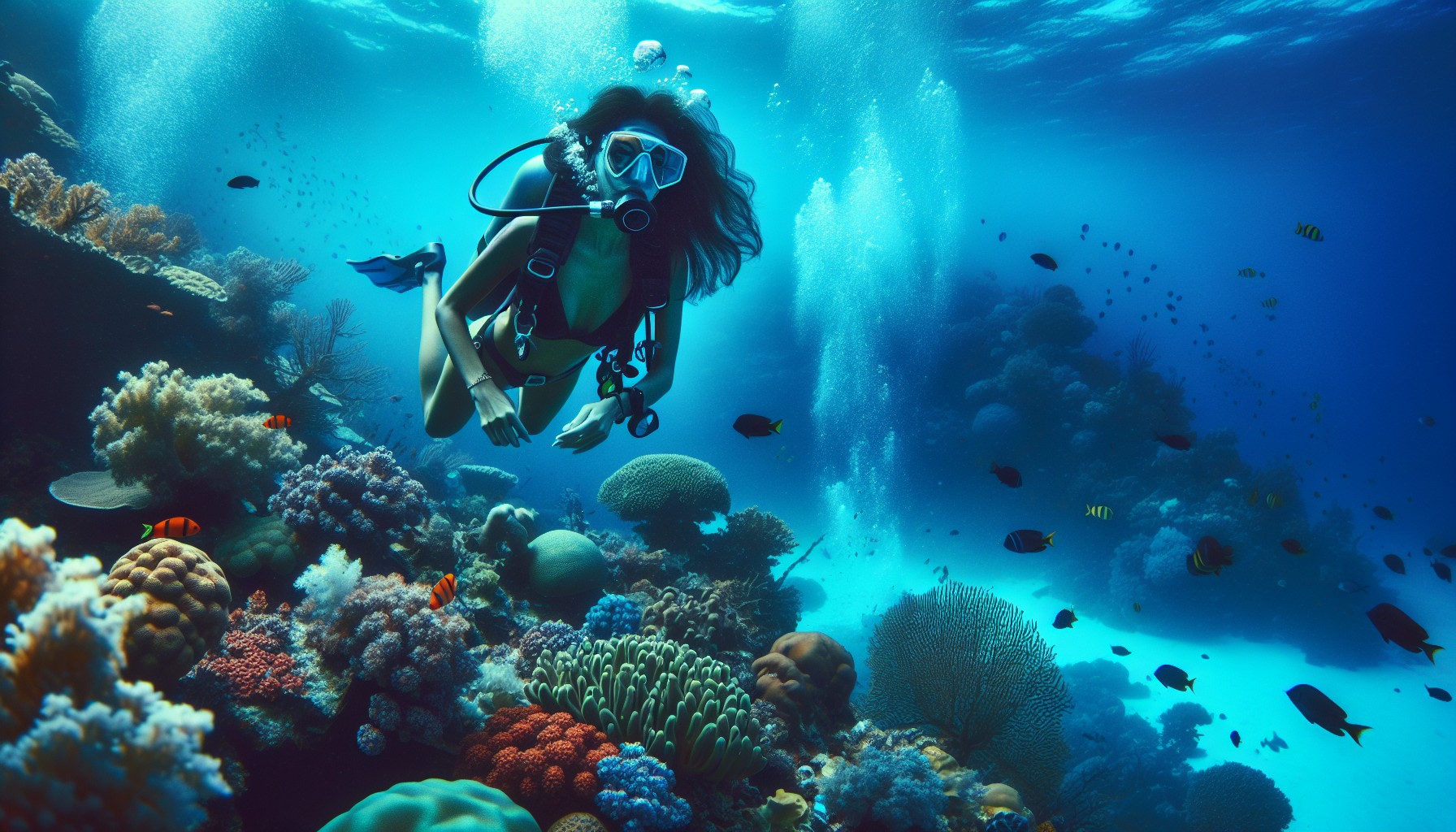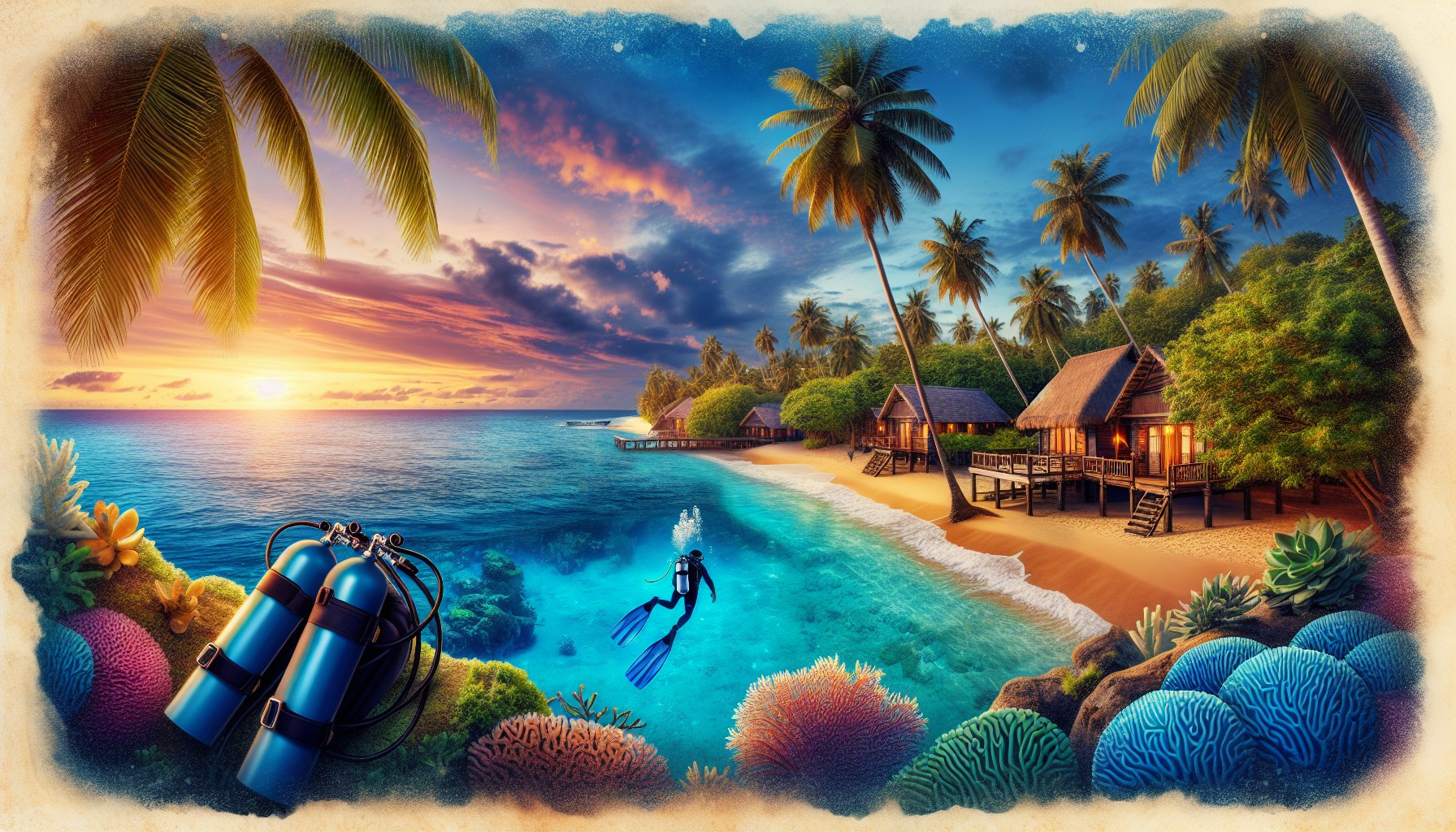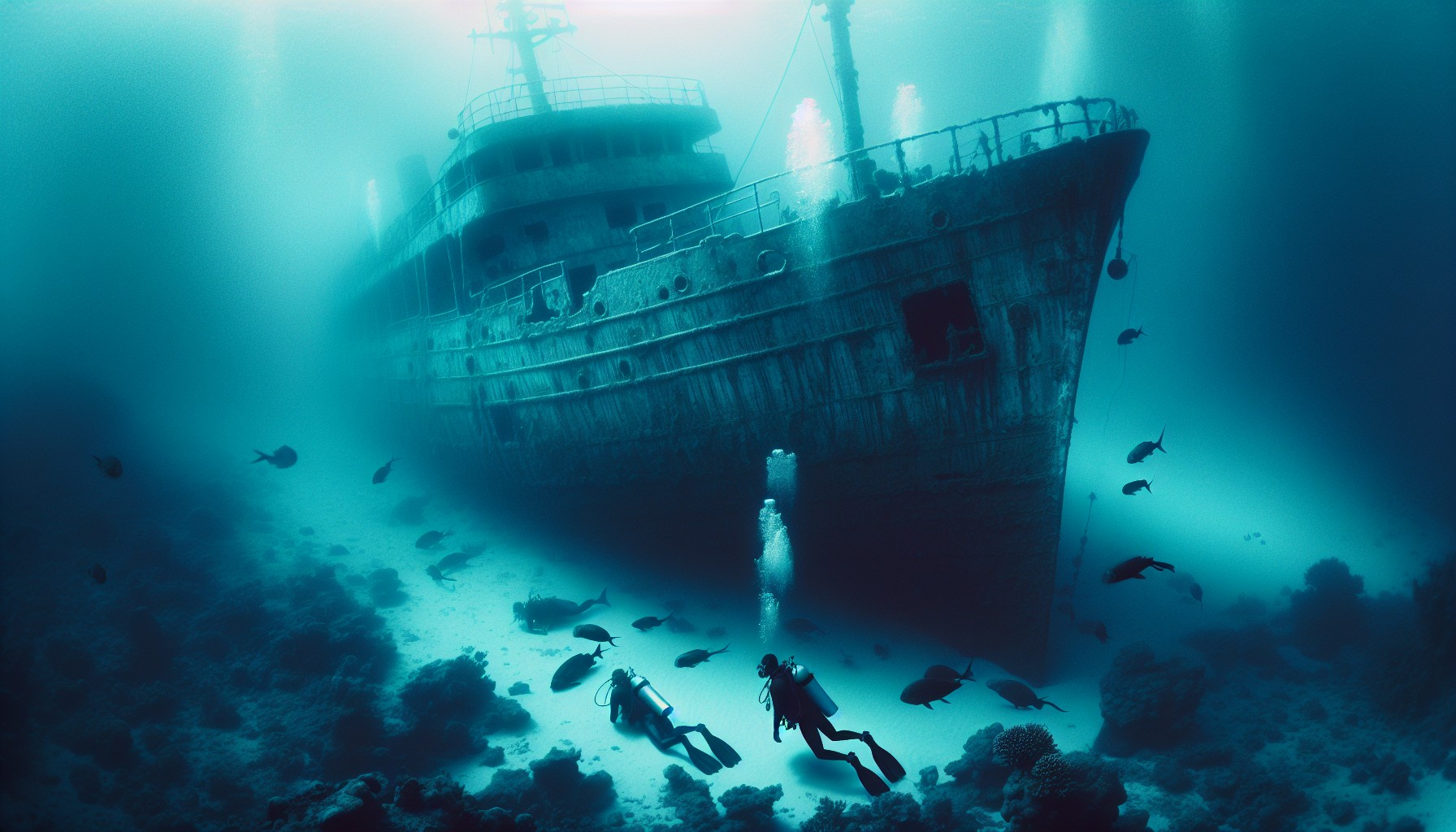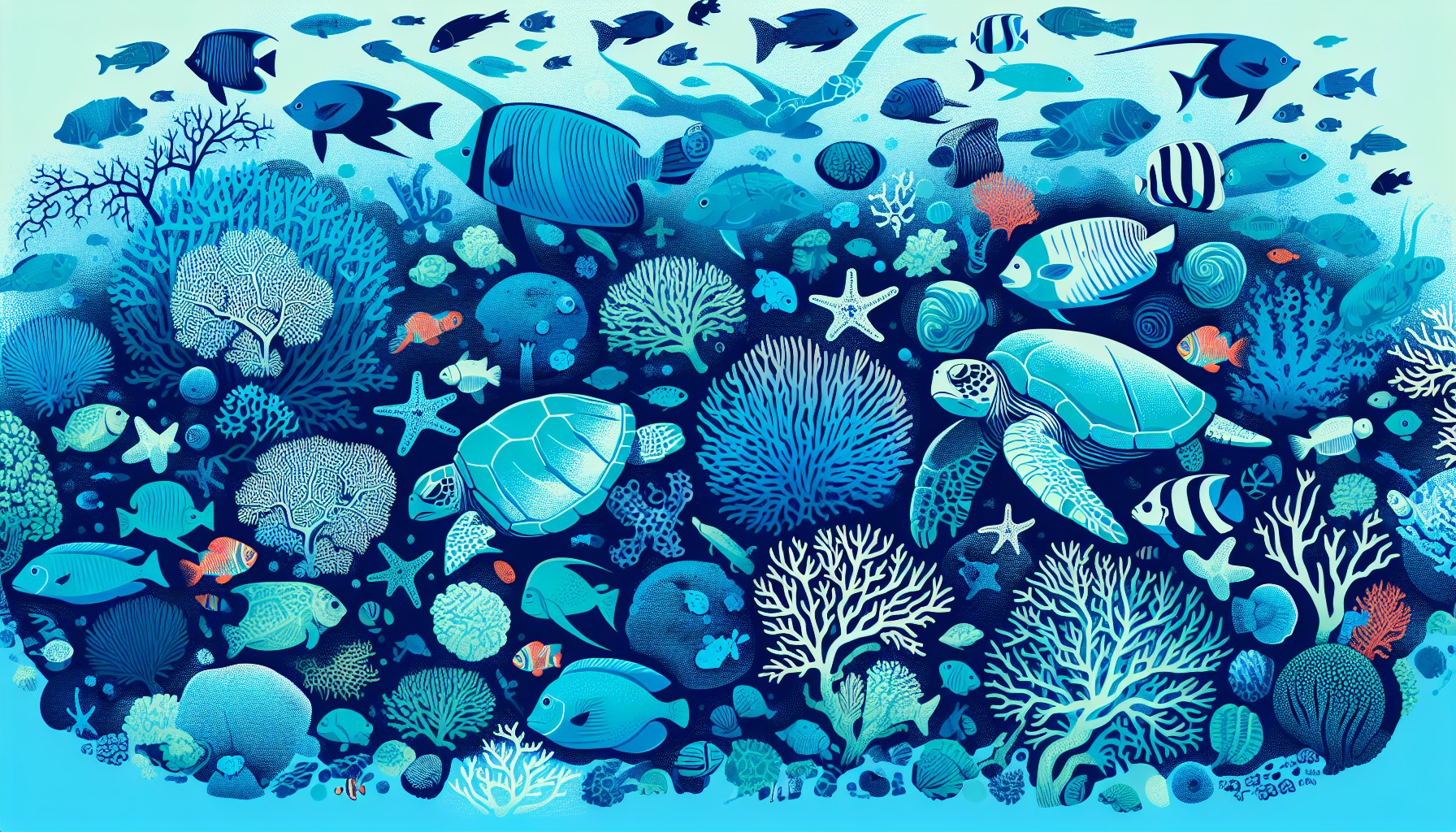Diving Sites in Sri Lanka
If you’re hearing the call of the ocean and have a thing for extraordinary underwater adventures, Sri Lanka should definitely be on your bucket list. This island paradise is renowned for its pristine beaches and the wild array of marine life hidden beneath its blue waves.
Reef Dives
Exploring Sri Lanka’s reefs is like entering a vibrant, bustling city under the sea. Imagine swimming alongside a parade of clownfish, butterflyfish, and turtles—like you’re an honorary member of an underwater neighbourhood! The reefs are bustling zones teeming with aquatic life, from the stealthy moray eels to the graceful gliding of a stingray. Oh, and if your timing’s just right, you might even spot a whale shark doing its round or a manta ray twirling gracefully.
To give you a sneak peek of the marine cast you’ll be diving with, here’s a list:
| Marine Life | Common Sightings |
|---|---|
| Reef Fish | Clownfish, Butterflyfish |
| Turtles | Green turtles, Olive ridleys |
| Rays | Stingrays, Manta rays |
| Eels | Moray eels |
| Sharks | Blacktip reef sharks, Whale sharks (seasonal) |
Wreck Dives
Diving into Sri Lanka’s wrecks is like opening up a treasure chest from the past. The coast is sprinkled with sunken ships that tell tales of yesteryears. You’ll find everything from tiny, colourful creatures like nudibranchs to big fellas like barracudas making these shipwrecks their permanent homes. Diving these sites means you get a fascinating blend of history and nature all in one go.
For more juicy details on where to find these underwater relics, have a look at our article on wreck diving in Sri Lanka.
| Wreck Dive Site | Notable Features |
|---|---|
| HMAS Sydney | WWII Shipwreck, Rich marine life |
| Rangoon | Cargo ship, Concrete reef formations |
| Pearl and the Mable | Fishing trawler, Great for macro photography |
Cave Dives
If you’re a diving thrill-seeker, the mysterious cave dives just off Sri Lanka won’t disappoint. These sites are treasure-hovels hosting marine creatures galore. Imagine swirling around with blue whales or pelagic hunters while you navigate through submerged ruins. It’s an adventure with nature’s playfulness thrown right in.
| Cave Dive Site | Highlights |
|---|---|
| Hikkaduwa Caves | Colourful coral formations, Marine life diversity |
| Pigeon Island | Clear waters, Rich biodiversity |
| Trincomalee Caves | Dramatic scenery, Large marine fauna |
With diving sites ranging from vibrant reefs to historic wrecks and mysterious caves, Sri Lanka’s offering is like an all-you-can-dive buffet platter. There’s something for everyone, whether you’re a newbie or an old hand at diving. Ready for your next underwater adventure? Take a look at our guide on Sri Lanka marine life for more info. And if you’re wondering where to rest after a thrilling day beneath the waves, check out our section on Sri Lanka dive resorts.
Marine Life in Sri Lanka
Exploring the depths of Sri Lanka offers an exciting treasure trove of marine creatures. It’s a dream spot for scuba fans, with all sorts of sea life like rainbow-colored fish, ancient turtles, and surprisingly friendly sharks. There’s as much variety down there as you’d find in a big ocean library.
Colourful Reef Fish
Dive into the waters and you’ll feel like you’ve stumbled onto a fishy festival. Here’s what you might bump into:
| Fish Species | What They’re Like |
|---|---|
| Clownfish | Orange and white, loves hanging in anemones—like a fishy hotel. |
| Sweet Lips | Blue-marked beauties with a quirky attitude. |
| Triggerfish | They sport some wild colours and are shaped like living art. |
| Batfish | Flat yet fabulous, they’ve got an eye-catching physique. |
These fancy fish aren’t just for show — they’re key players in keeping the reefs lively and beautiful. The coral acts like a high-rise building, playing landlord to these little guys and keeping the underwater neighbourhood buzzing with life.
Turtles, Rays, and Moray Eels
Sri Lanka’s waters play host to some bigger, fascinating friends too. Try and catch a glimpse of these:
| Species | Their Style |
|---|---|
| Sea Turtles | These glide the way we’d all like to, calm and slow. You’ll spot green and hawksbill varieties. |
| Eagle Rays | With their wings, they fly underwater like nature’s best ballerinas. |
| Bull Rays | Big and bold, these look like underwater bouncers. |
| Moray Eels | Shy but intriguing, they hang out in reef nooks like they’re on a secret mission. |
Meeting these gentle creatures is a highlight reel moment: full of ‘wow’ factor and perfect for the holiday snaps.
Shark Species in Sri Lanka
For those who like a splash of adventure, Sri Lanka has some shark-shaped surprises in store. Look out for these celebs of the sea:
| Shark Species | The Lowdown |
|---|---|
| Whale Sharks | The ocean’s gentle giants, humongous but calm enough for a selfie. |
| Bull Sharks | Tough and sturdy, they cruise the coast like seasoned sailors. |
| Hammerhead Sharks | They sport the craziest headgear you’ll ever see, and they love to hang out in groups. |
Divers often find their encounters with these big fellas to be the absolute highlight of their trip. Sharks aren’t only awesome: they’re vital team members in the watery ecosystem playground. To dive deeper into the details, wander through Sri Lanka marine life.
Sri Lanka’s underwater world is a thrill-a-minute paradise, no matter if you’re just getting your fins wet or you’re a seasoned pro. With vibrant reef fish, majestic turtles, and a smattering of sharks, there’s always a new escapade waiting beneath the waves. If you’re keen on turning your dive into a dream holiday, check out Sri Lanka dive resorts for more adventures and a place to crash afterwards.
Best Time to Dive in Sri Lanka
Timing is everything when it comes to planning a scuba adventure in Sri Lanka. Depending on the time of year and location, the diving experience can vary greatly, thanks to the country’s changing weather. Without further ado, here’s when to hit the waters on Sri Lanka’s west, south, and east coasts.
West and South Coasts (November-April)
If you’re heading to the west and south coasts, mark your calendars for the magic window from November to April. During these months, the weather is as sunny as a holiday photo shoot, and the seas are chill enough for divers, whether you’re a newbie or a veteran. The air’s usually nice and toasty, hanging around 77-86°F (25-30°C), making those wet suits just right.
| Month | Weather | Average Air Temperature (°F) |
|---|---|---|
| November | Bye-bye, monsoon | 77-86 |
| December | Sun-soaked skies | 77-86 |
| January | Quiet, calm seas | 77-86 |
| February | Diver’s delight | 77-86 |
| March | Sunshine galore | 77-86 |
| April | Time to ponder the rain | 77-86 |
Places like Colombo and Hikkaduwa are calling during this sunny stretch, with routine dives on offer nearly every day. If you’re curious about where to stay before you dive, check out our handy Sri Lanka dive resorts guide.
East Coast (May-October)
From May to October, the east coast is where the diving action heats up. Thanks to a dry spell, the water clears up beautifully, almost like flipping a switch for perfect visibility. The temperatures? Still sticking to that comfy 77-86°F (25-30°C), making it all the more inviting to get your fins wet.
| Month | Weather | Average Air Temperature (°F) |
|---|---|---|
| May | Catchin’ dry vibes | 77-86 |
| June | Clear as day | 77-86 |
| July | See the fish, clear as a bell | 77-86 |
| August | Warm welcomes | 77-86 |
| September | Perfect for a plunge | 77-86 |
| October | Rain sneaking back | 77-86 |
Trincomalee’s shores are begging to be explored over this spell, especially if you’re game for spotting some shoals or delving into the deep blue. Lovers of animals under the sea might want to peek at our info on Sri Lanka marine life for all the fin-tastic happenings.
Whether it’s watching a sunset dip or hunting for hidden treasures beneath the waves, Sri Lanka lets you dive like there’s no tomorrow, any time of year. A bit of prep around the rainy seasons, and you’re in for experiences that’ll splash around your memory bank for ages!
Diving Regulations in Sri Lanka
Taking a plunge into the waters of Sri Lanka is a thrilling adventure, but it ain’t without its rules! Dive buddies are expected to follow a few guidelines to keep things safe and stay eco-friendly. Let’s break down the basics on what you need to do before donning your flippers and mask.
Certification Requirements
Imagine rocking up to a Sri Lankan dive centre—they’ll wanna see your creds before you get in the water. A certification from a legit agency is usually a must to rent gear or join a group dive. But worry not, rookies! Dive schools dotted across the country offer plenty of intro classes to get started.
| Certification Level | Required Experience |
|---|---|
| Open Water Diver | Nada! You can take it as a starting point |
| Advanced Open Water Diver | Knockout 5 dives after your newbie cert |
| Rescue Diver | Need your advanced badge first |
| Divemaster | Rack up a hefty 60 dives, buddy! |
If you’re curious about getting that PADI badge, have a squiz at PADI Certification in Sri Lanka.
Sustainable Diving Practices
While you’re floating beneath the waves, it’s crucial to keep an eye on the ocean’s wellbeing. The marine life deserves some love and space, so here’s how not to ruffle the feathers (or scales) of our underwater pals:
- Keep Your Hands to Yourself: These critters don’t need a helping hand. Best to watch from afar so neither they nor you get a fright.
- Sunscreen Savvy: Swap the usual sun cream for reef-friendly stuff to avoid those pesky chemicals harming the corals—a little kindness goes along way.
- Back Community Projects: Dive ops that get stuck into coral growing or educate the locals rock! Joining forces with them gives the reefs a fighting chance.
Stick to these tips and you’ll not only have an ace time under the sea but play a part in keeping Sri Lanka’s aquatic treasures in tip-top shape. For more on the wild things you might see out there, head over to Sri Lanka Marine Life.
Diving Courses in Sri Lanka
Ready for some underwater magic? Sri Lanka’s got some sweet diving courses for those itching to see what the ocean’s got tucked away. One that’s catching everyone’s eye is the PADI Open Water Diver Course. Plus, over at Divinguru Nilaveli Resort, there’s a dive-packed experience waiting for both newbies and salty sea dogs.
PADI Open Water Diver Course
The PADI Open Water Diver course in Sri Lanka breaks it down into three key things:
- Learning Stuff: This is all about nailing the basics, understanding the lingo, and figuring out how to stay safe when you’re scuba diving.
- Pool Shenanigans: You’ll hit the pool for some hands-on practice with your gear, getting comfy with everything before you head out.
- Ocean Dives: This is where you get to show off your new skills in the big blue. Think of it as a mix of adventure and classroom.
Crack through this course, and boom, you’ve got a ticket to dive anywhere worldwide, up to 18 metres deep. It’s like unlocking a backstage pass to explore scuba diving in Sri Lanka.
| Part of Course | What’s Happening |
|---|---|
| Learning Stuff | Basics, lingo, and safety stuff. |
| Pool Shenanigans | Gear practice in pool. |
| Ocean Dives | Skill showoff and ocean explore. |
Divinguru Nilaveli Resort’s Offerings
Divinguru Nilaveli is a top spot right on Nilaveli Beach. They’re open from March through October, then switch over to Divinguru Unawatuna in the south once the rains roll in. They do the PADI course too, and they’re just a hop away from Pigeon Island where you might rub some shoulders with Black Tip Reef Sharks and turtles—no biggie.
This place is all about keeping it chill and welcoming, making sure everyone from first-timers to seasoned pros feels right at home and gets the best out of their dive experience.
| What They Got | Perks and Pluses |
|---|---|
| PADI Open Water Diver | All-round training with worldwide dive freedom. |
| Locale | Beachside at Nilaveli – diving right from your doorstep. |
| Cool Spots Nearby | Quick boat ride to Pigeon Island for some gnarly snorkeling. |
If you’re craving more sea adventures, snoop around what other Sri Lanka dive resorts have on tap. And while you’re at it, get the lowdown on the marine life in Sri Lanka to really plan your deep-sea escapades.
Top Dive Spots in Sri Lanka
For thrill-seekers and ocean adventurers, Sri Lanka’s underwater world offers endless wonders. Whether you’re a rookie or have a few dives under your belt, there’s something here for everyone. Let’s plunge into some of the best dive spots you’ll find in this island paradise.
Hikkaduwa Dive Sites
Hikkaduwa, located on the southwest coast, is a hot spot for those keen on scuba diving. Its waters accommodate everyone—whether you’re just starting or have been around a few reefs already. The deepest diving goes to about 30 meters down, so all you need is your trusty Open Water Diver certification to join the adventure.
| Dive Highlights | Information |
|---|---|
| Depth Range | Up to 30 meters (98 feet) |
| Certification | Open Water Diver needed |
| Marine Life | Spot butterflyfish, parrotfish, and moray eels |
The coral reefs in Hikkaduwa are lively and vivid, offering scenes that make even seasoned divers gasp in awe.
Unawatuna Dive Locations
Found along the southwest coast, Unawatuna tempts divers with shallow waters and deeper plunges, like at the legendary Galle Shipwreck. This wreck sits between 18 to 30 meters down, sweet spot for those with an Advanced Open Water Diver ticket, especially with those robust currents. It’s worth every bit of effort to see these underwater attractions.
| Dive Sites | How Deep? | Price (INR) | Price (USD) |
|---|---|---|---|
| Galle Shipwreck | 18-30 meters (60-100 feet) | 3,900 | 55 |
| Ralagala Wreck | Changes with tides | 3,900 | 55 |
| Goda Gala Diyamba | Changes with tides | 4,600 | 65 |
With at least ten coral reef sites, Unawatuna’s got something for every diver, from novices to those looking to tick off another site from their list.
Trincomalee’s Diving Experiences
Head over to the northeast, and you’ll hit Trincomalee, a prime spot for those seeking top-notch diving action. Hot picks like Swami Rock and Pigeon Island bring unique thrills.
Swami Rock takes the plunge from 10 to 30 meters, welcoming divers of all levels. On the other hand, Pigeon Island boasts of its status as a marine sanctuary. While it favours the Open Water certified, it’s a treasure for snorkelers and divers, showing off a vibrant mix of marine species.
| Dive Highlights | Information |
|---|---|
| Swami Rock Depths | 10-30 meters (33-100 feet) |
| Certification | Open Water preferred at Pigeon Island |
| Starting Boat Dive Price | INR 3,300 |
Trincomalee is where you find Pigeon Island with its lively coral reefs, full of fish, anemones, and brightly coloured nudibranchs, ensuring every dive is a magical journey.
Consider Sri Lanka for your next diving break, and you’re in for memories that last a lifetime. Want more nitty-gritty on where to dive and stay? Check out our reads on Sri Lanka dive resorts and wreck diving in Sri Lanka.



